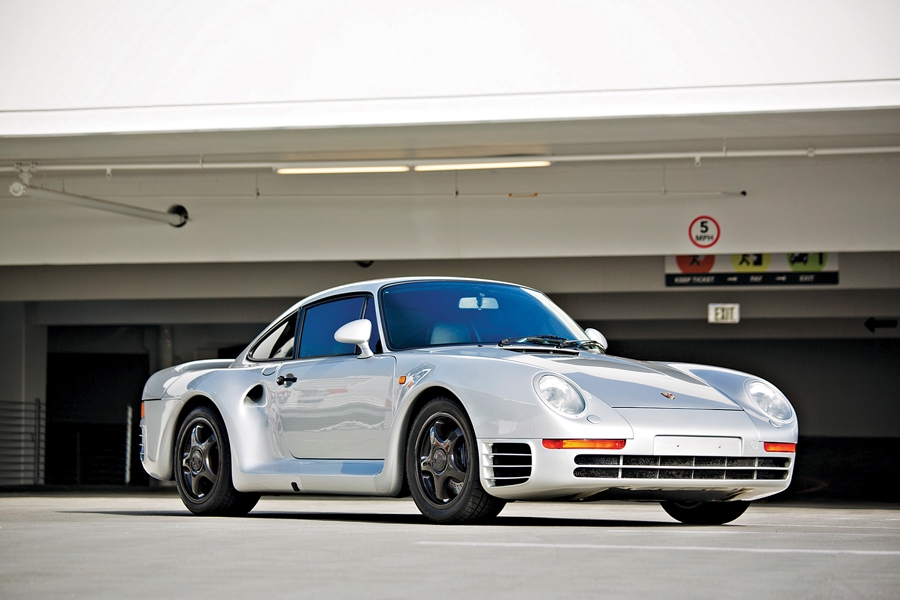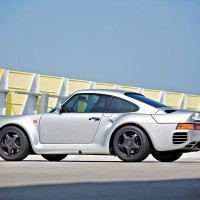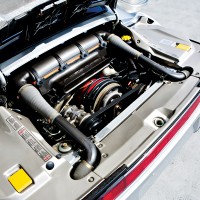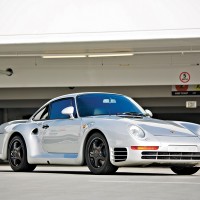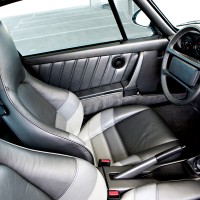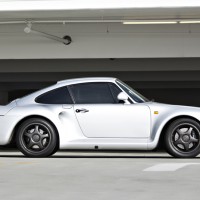SCM Analysis
Detailing
| Vehicle: | 1988 Porsche 959 Komfort coupe |
| Number Produced: | 329 (all variants) |
| Original List Price: | $227,000 |
| Chassis Number Location: | Stamping on right inner fender; aluminum tag next to hood latch |
| Engine Number Location: | Vertical boss under engine fan on right side |
| Club Info: | Porsche Club of America |
| Website: | http://www.pca.org |
This car, Lot 35, sold for a world record $1,485,000, including buyer’s premium, at Gooding & Company’s Pebble Beach Auction on August 16, 2014. A late-bloomer in the current pricing bubble, 959s are now high-profile, as they should be. 959s are the archetype “supercars.”
These cars were not submitted for U.S. crash-test standards, and it has been very difficult to import one in the United States. However, most are now 25 years old, which makes them completely legal to import into the United States.
The beginning of a supercar
In 1983, Porsche President Peter Schutz and Technical Director Helmuth Bott hatched the plan for a new 911 race car to develop technology that could later be adapted to production cars. The motivation came from the FIA’s new Group B, a rally car spec that required 200 “production” examples. Porsche did not believe they could sell that many rally cars. The project quickly morphed to a limited-edition street car.
Porsche showed a “dream car” prototype 959 in Pearlescent White at the 1983 Frankfurt Auto Show. Over the next two years, engineering progressed steadily, but it was not until the 1985 Frankfurt Show that a series of Weissach-built prototypes were in testing. About 1,600 orders flowed in over the next six months against a price of about $150,000. Ultimately, the 959 cost about $227,000.
Porsche tried to winnow out speculators, reducing purchase contracts to 250. That screening did not work, and 959 contracts regularly sold for 50% or more over MSRP. Deliveries were slated for a year later — in September 1986. Glitches and refinements delayed deliveries until May 1987 and cars were finished through 1988.
A hand-built exotic
The Porsche 959 was hand-produced. Porsche built the superstructure, while Baur made the body panels. It was all put together on the second floor of a slightly remote old building with room for about 12 cars, sub-assemblies, and parts.
Output never got above three cars a week, soaking up many times the man hours of a production Porsche. Investigating journalists have written that Porsche lost 50% of their direct costs on every 959 and 75% of total costs including amortized development. Fortunately, 1984 and 1985 were relatively profitable years for Porsche at about $30 million and $50 million, respectively. That — and some creative cost allocating — kept the 959 afloat.
So what did a buyer get with a 959? It was the first supercar, and an exotic one at that. Only the inner structure and passenger’s compartment derived from a production 911. Doors and hood were a strong, light aluminum alloy. All four fenders and the roof were layered carbon fiber; the floor panel was honeycomb carbon fiber. The bumpers were of more mundane polyurethane and fiberglass.
Complexity and microcomputers
The suspension combined the best of Porsche’s race technology with a double wishbone suspension modified for adjusting hydraulic shocks that managed damping and self-leveling. The four-wheel-drive system was also innovative, with driver-initiated and self-adjusting torque splits driven by electronics that detected load changes. The gearbox was a new Getrag 6-speed. Brakes were redesigned four-piston calipers with ABS engineered to work with four-wheel drive. Carrying the car were Speedline wheels made for run-flat tires with low pressure warnings through hollow-spoke wheels. Microcomputers abounded.
The heart of the car was the race-derived 2,849-cc engine, which had six cylinders, seven main bearings, four valves per air-cooled cylinder, oil-cooled pistons, titanium connecting rods, sodium-filled exhaust valves, water-cooled heads, and four overhead cams. Motronic engine management oversaw twin turbochargers operating sequentially — not simultaneously as with race cars — to about 14 pounds per square inch. The engine delivered 444 horsepower and peak torque of 369 foot-pounds.
Why almost $1,500,000?
Gooding’s 959 sale in Monterey set a world record price for a Komfort. It was a huge jump in a renaissance of appreciation — both emotional and financial — for 959s.
Back in the bubble days of 1989–90, 959s were in high demand, but then dropped off the radar. Thought to be dated in appearance and complex/expensive to maintain, they were eclipsed by almost all the RS models from 1973 up, by 993 GT2s, and by some Turbo specials. From 2008 through 2011, prices and high bids on 959 Komforts reported in the SCM Platinum Auction Database started at $266,600 — with only two cars breaking $300,000.
959s were the technological marvels of their day. They were one of the few noteworthy cars of the 1980s, and they are rare. Porsche built only 329 in total, including 29 959Ss also known as Sports, which forsook the hydraulic suspension and all luxury equipment and are more prized and more expensive today.
When the 959 market started its upward march about three years ago, 959S cars led the charge, moving above $1,000,000 about two years ago, while 959 Komforts were still $500,000. So far in 2014, two Komforts at auction brought $687,500 and $759,000.
The Gooding Monterey car was a low-mileage (5,468 miles) Komfort. It had excellent service records, very important on a car as complex as a 959, where buyers often want to see only factory service. It was handsome in metallic silver, although non-stock with black wheels and blacked-out windows. All that aside, the car was extremely well sold, the confluence of good car, increasing interest in 959s, an overall rising tide, and at least two determined bidders. ♦
(Introductory description courtesy of Gooding & Company.)
